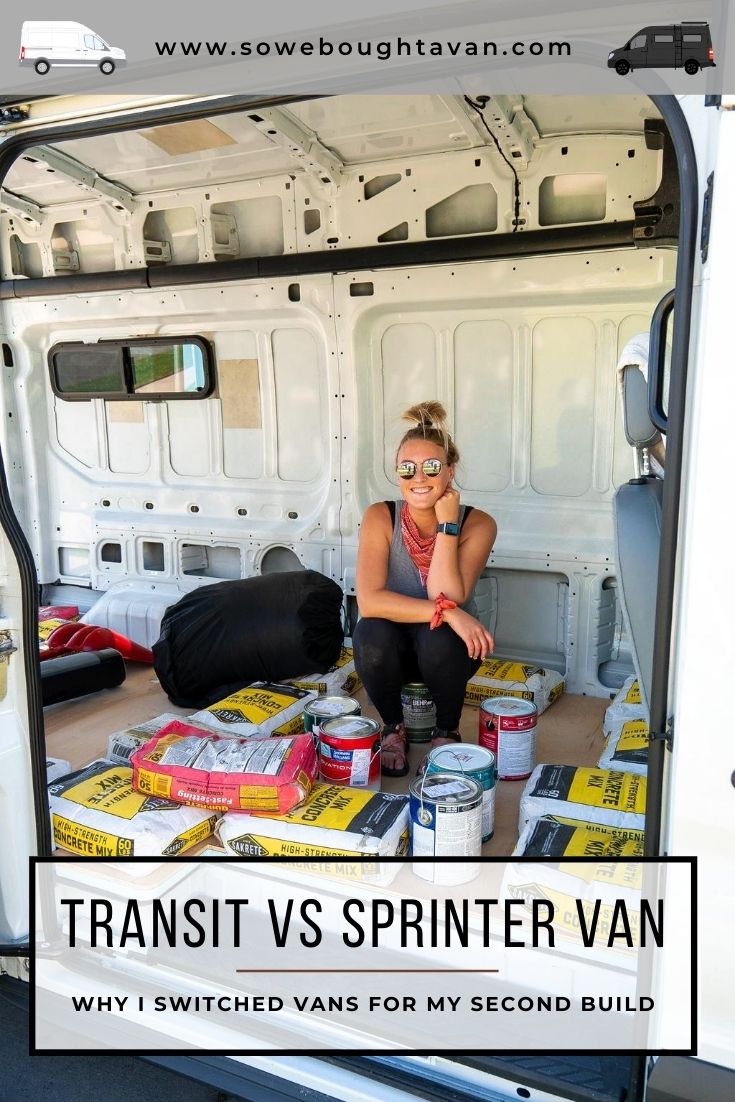Transit Vs Sprinter: a Side-by-Side Comparison
Choosing the best vehicle for van life is an important decision that should include research, test-driving, and extensive thought.
If you’re thinking about diving into van life, whether part-time or full-time, you’ll want to make sure you choose a vehicle that’s right for you. There are an abundance of van options, but in this blog post I’m going to be comparing the Ford Transit to the Mercedes Sprinter. I’ve been living on the road full-time for over 3 years and recently made the switch from Sprinter to Transit. My partner and I just purchased a 2016 148″ WB Ford Transit High Roof with 20,000 miles on it. My previous van (that I still own and am renting out on Outdoorsy), is a 2016 144″ WB Mercedes-Benz Sprinter High Roof with 100,000 miles on it. So, here is my opinion as an owner of both vans, regarding the ongoing debate of Transit vs Sprinter.
A few things to think about when you're deciding what kind of van you want to get:
- BUDGET: How much are you able to spend on your vehicle? Would you rather pay more up front for the cost of a newer vehicle or more on fixing up an older vehicle? Also, consider the make of the car and where you'll need to get it serviced or worked on. Dealerships/specialty engines require specialty mechanics and cost more.
- HEIGHT: How tall are you? Interior standing height of a high roof Transit is 4 inches taller than the interior standing height of a high roof Sprinter. You'll want about 2 inches (at least) for ceiling and floor insulation/installation, so if you're over 6'2", consider the Transit.
- LIFESPAN: How long do you plan on having your van? Do you plan to sell it after you're done using it? Sprinters are usually diesel (years 2019-2020 are now available in gas too) while Transits are usually gas (year 2020 is now available in diesel too). Diesel vehicles have a much longer lifespan than gas vehicles. This adds to Sprinters having a much higher resale value, if you plan to sell yours down the line.
- NEW VS USED: This is a big one. Buying new is obviously more expensive and you will have to eat the depreciation cost. BUT you'll also have a reliable car under warranty and have an easier job financing it (if you need a loan). Buying a lightly used van is ideal, something with low mileage and a clean history, that still has its warranty. I bought my first van (Sprinter) brand new, which was a great option for me since I ended up traveling in it as a solo female for years. However, my second van (Transit) I bought lightly used, with the warranty still in tact and under 20,000 miles.
- USAGE: What do you plan to use your van for? Chase snow for mountain sports? Then consider a 4x4. If you plan to chase warm weather, 4x4 is fairly unnecessary and an easy cost to cut. If you plan to stealth, you'll want to go with a more discrete, potentially compact van. Lose the exterior accessories if you're worried about going unnoticed. Figure out your "why" and that will help you decide which van is best for you.
NOTE: both the Transit and Sprinter are available in standard/medium roof OR high roof (with the exception of the 130″ wheelbase, which is not available in a high roof). It is my personal opinion that one of the reasons to pay for a panel van (i.e. a Transit, Sprinter, ProMaster, etc.) is the benefit of the height of the vehicle. I’ve known a handful of people to purchase, convert, and live/travel in medium roof Transits and they all ended up either selling or upgrading to a high roof eventually. Due to this, I will only be listing details and specs about the high roof versions of the Transit and Sprinter vans.
FORD TRANSIT

Transits are a bit newer in the van conversion world, but I believe they are seriously up-and-coming. Transits are generally at least a few thousand dollars behind Sprinters in cost, whether new or used. Price points on a Transit can be anywhere from roughly $14,000 for an older, used van, all the way up to just under $40,000 for a new 2020 Transit.
The Transit comes in many variations, but most commonly in North America, it is available in 3 different sizes/wheelbases:
- 130" wheelbase
- 148" wheelbase
- 148" wheelbase extended
TRANSIT SPECS
130″ WHEELBASE FORD TRANSIT CARGO VAN
Exterior length: 217.8 inches
Exterior height: 109.6 inches
Interior standing height: 79.1 inches
Interior cargo length: 132.9 inches
Interior cargo width: 77.0 inches
Cargo volume: 372.8 cubic feet

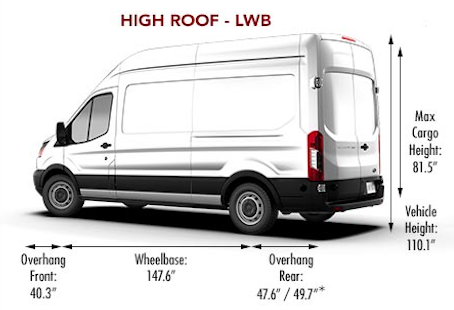
148″ WHEELBASE FORD TRANSIT CARGO VAN
Exterior length: 235.5 inches
Exterior height: 109.6 inches
Interior standing height: 81.5 inches
Interior cargo length: 143.7 inches
Interior cargo width: 77.0 inches
Cargo volume: 404.3 inches
148″ WHEELBASE EXTENDED FORD TRANSIT CARGO VAN
Exterior length: 263.9 inches
Exterior height: 110.4 inches
Interior standing height: 79.1 inches
Interior cargo length: 172.2 inches
Interior cargo width: 77.0 inches
Cargo volume: 487.3 cubic feet
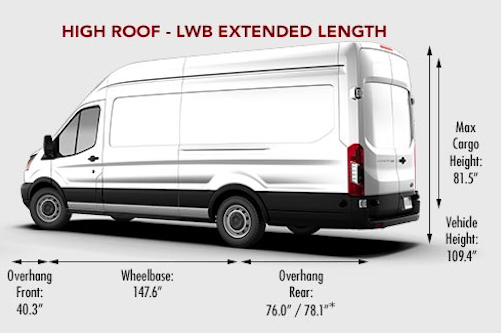
PROS
- Drive comfortably, more like a normal sedan
- Low maintenance costs - can be worked on nearly anywhere, so you skip dealership pricing and can be serviced more easily in various locations
- Highest roof of any panel van - 2.4 more inches of standing room than Sprinters
- Available in AWD (just gas model)
- Vehicle parts are easy to find and much more reasonably priced
CONS
- Lower gas mileage, with most models getting MPG in the mid-teens
- Less popular within the van community, which means less resources available to you based on others experiences
- Shorter life span than a diesel vehicle
- Transits have a lower clearance height than Sprinters
Conclusion: The most note-worthy point here is that Transits are the more affordable option. They are a bit newer in the van conversion world, but I believe they are an extremely underrated van that doesn’t get enough attention. The Transit is not quite as common or popular as the Sprinter for campervan conversions, but I think that is changing. I also believe that as we are beginning to see Transits more often in the van world, conversion and accessory companies are starting to catch up and create more Transit products and options. Even Ford itself is stepping up their game! The 2020 Transits are now available in diesel and all wheel drive (AWD) options.
In my personal opinion, I believe that the Transit is a great option that can provide almost exactly what the Sprinter can provide. As long as you are not wanting a 4×4 vehicle or looking to have your van for the rest of your life, a Transit is a wonderful van option for conversions and traveling. It is more affordable upfront and more affordable for regular and surprise maintenance. One of the benefits of this vehicle that I appreciate as a full-time traveler is that it can be taken to any mechanic to be worked on and does not require extensive specialty knowledge or a dealership. Overall, it is an extremely sensible purchase and fairly priced, with all the benefits of a panel van.
MERCEDES SPRINTER

The first important thing to note is that Sprinters are all made by Mercedes: yes that means there are Mercedes Sprinters, Freightliner Sprinters, and Dodge Sprinters. While they may have different decal, their engines are the same. Price points on a Sprinter can be anywhere from $20,000 for an older, used van, all the way up to $60,000+ for a new 2020 4×4 Sprinter. Generally speaking, a 4×4 vs 2WD Sprinter will cost about $20,000 more.
The Sprinter comes in many variations, but most commonly in North America, it is available in 3 different sizes/wheelbases:
- 144" wheelbase
- 170" wheelbase
- 170" wheelbase extended
SPRINTER SPECS
144″ WHEELBASE MERCEDES SPRINTER CARGO VAN
Exterior length: 233.5 inches
Exterior height: 107.5 inches
Interior standing height: 79.1 inches
Interior cargo length: 132.9 inches
Interior cargo width: 70.4 inches
Cargo volume: 372.8 cubic feet
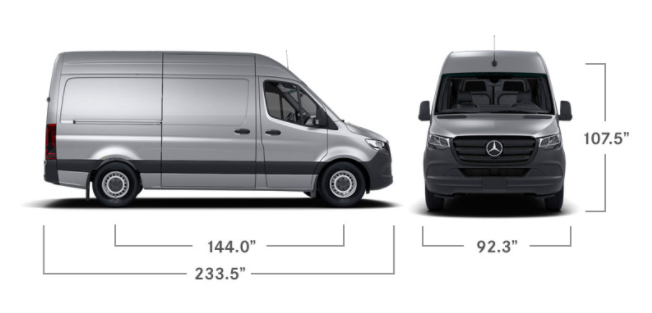
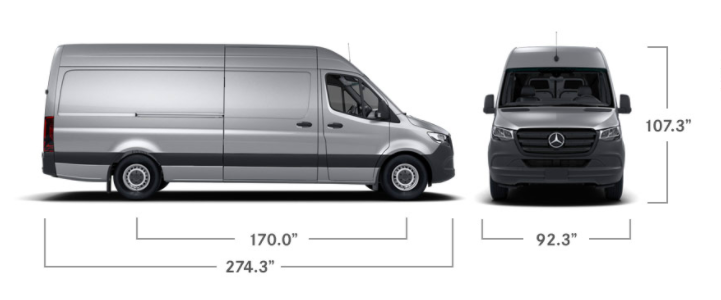
170″ WHEELBASE MERCEDES SPRINTER CARGO VAN
Exterior length: 274.3 inches
Exterior height: 107.3 inches
Interior standing height: 79.1 inches
Interior cargo length: 173.6 inches
Interior cargo width: 70.4 inches
Cargo volume: 488.1 inches
170″ WHEELBASE EXTENDED MERCEDES SPRINTER CARGO VAN
Exterior length: 290.0 inches
Exterior height: 107.0 inches
Interior standing height: 79.1 inches
Interior cargo length: 189.4 inches
Interior cargo width: 70.4 inches
Cargo volume: 532.6 cubic feet
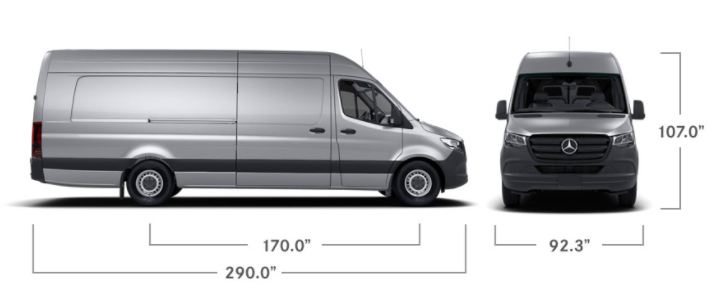
PROS
- Good gas mileage for a van! Diesel 2WD Sprinters usually get low 20's
- Drive comfortable, like an SUV and have a GREAT turning radius
- Popular option within the van community, which means more resources available to you based on others experiences
- Longer life span! Diesel vehicles tend to last (roughly) twice as long as gas vehicles, potentially to even 400k miles!
- Available in both 4x4 and RWD
- Sprinters have a higher payload so they can handle heavier builds more easily
- Better clearance than other panel vans
CONS
- High maintenance costs - Mercedes, and Sprinters specifically, are complicated vehicles to work on and require specific knowledge, which usually means getting them worked on at the dealership
- Sprinters are definitely the most expensive vehicle upfront
- There are specific years to stay away from. 2007-2014 have a reputation for having DEF (diesel exhaust fluid) system issues, which is expensive to fix
- Wait time for vehicle parts can be LONG if you're located in the United States
- Requires Ultra Low Sulfur Diesel (ULSD), which can be harder to find
CONCLUSION: All of this is to say that the Sprinter is a great van option, but definitely the more expensive option as well. If you’re able and willing to pay for this more expensive van, then I believe it is a great investment. The vehicle’s lifespan will be longer, which will allow you to invest in something that will serve you for many more years. This is extremely beneficial if you plan to a.) keep it for a very long time and travel in it part-time/on the weekends, b.) keep it for a long time and use it part-time/rent it out part-time, or c.) plan to use it then sell it. The Sprinter is definitely extremely popular within the van life community as well, which makes guides, layouts, general information, tips and hacks all readily available online. Sprinters have better clearance, 4×4 options, are mostly diesel, and have been around for a long time.
BUT I cannot emphasize the cost of these things enough. As the sole owner of a 2016 Sprinter, the upfront cost is brutal. My Sprinter is currently financed and my monthly payments are intense. And that is just the upfront/regular cost of this vehicle. What really gets me is the maintenance. Sprinters require two different kinds of regular maintenance (service A and service B) which occur every 20,000 miles or so. Service A tends to be anywhere between $300 (the cheapest I’ve ever experience) up to $800. Service B usually requires a signature right at drop off that approves a minimum charge of $1,000. My most expensive trip to the dealer was for a service B + full brake system replacement, and I walked out the door paying just over $3,000. For somebody that has a solid savings account and plans ahead for these kinds of costs, it is worth it to have this long-term, reliable vehicle. But as a 28-year-old self-employed individual, it can be a money suck.
Overall, I do love Sprinters and do recommend them, if you can afford them. Maxing out your budget and purchasing a Sprinter without a savings account is very risky. Buying them new allows you to care for the vehicle to your highest capability, potentially minimizing the risk of issues down the line. But even used Sprinters can be spendy and tend to be within the years I’d be careful of (2007-2015). If you have the budget, the Sprinter is a great, comfortable, and fairly luxurious van choice.
OVERALL CONCLUSION
Here is the thing, and you probably won’t like this, but they are both great options. I wouldn’t necessarily say one is BETTER than the other. What I would say is that each van has its pros and cons and the vehicle I would recommend for you will absolutely depend on your situation. And you hopefully can trust what I’m saying and know I’m not BS-ing because I currently own BOTH a Transit and a Sprinter.
My first van is a 2016 Mercedes Sprinter and my second van is a 2016 Ford Transit. Both vans are wonderful and have been perfect mechanically. I’ll be honest and say that Sprinters are designed and engineered better and are definitely nicer/more luxurious. BUT as far as functionality goes, Transit vs Sprinter perform nearly the same (aside from the gas vs diesel aspect). My Transit is going to allow me to do pretty much exactly what my Sprinter allows me to do, but just for cheaper. Once again, the Transit won’t live as long, but for the purpose I’m using it for (and for $18k cheaper), that doesn’t really matter. Additionally, my personal experience is that owning a Ford Transit (so far) is exponentially less stressful than owning a Mercedes Sprinter. I’m not as worried about every little ding and dent, because at the end of it all, I have $18,000 less invested in my Transit. PLUS, if something does go wrong or I get in an accident, I can take it to pretty much any mechanic and have it worked on for a fraction of the price compared to my Sprinter.
If I HAD to summarize this debate simply, here is what I would say: Sprinters are wonderful and probably a bit nicer but if money is part of your decision-making process, a Transit will give you essentially what a Sprinter will, just for much cheaper.
Interested in following along with my current 2016 Ford Transit van build? Check out my build videos HERE!

